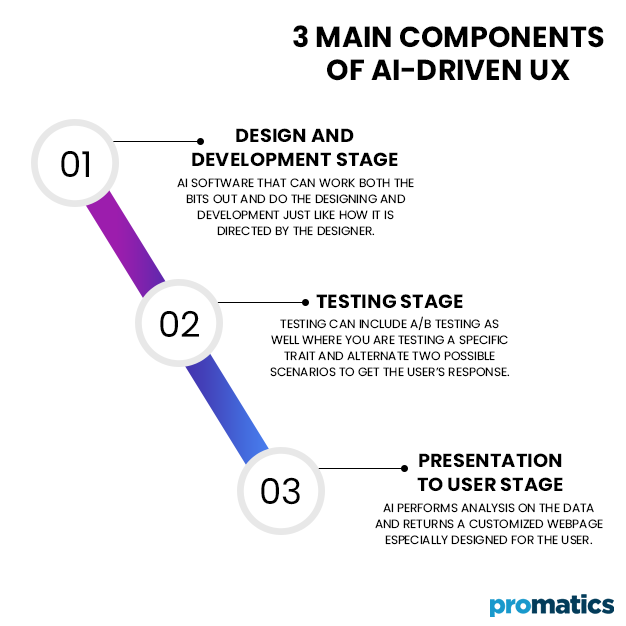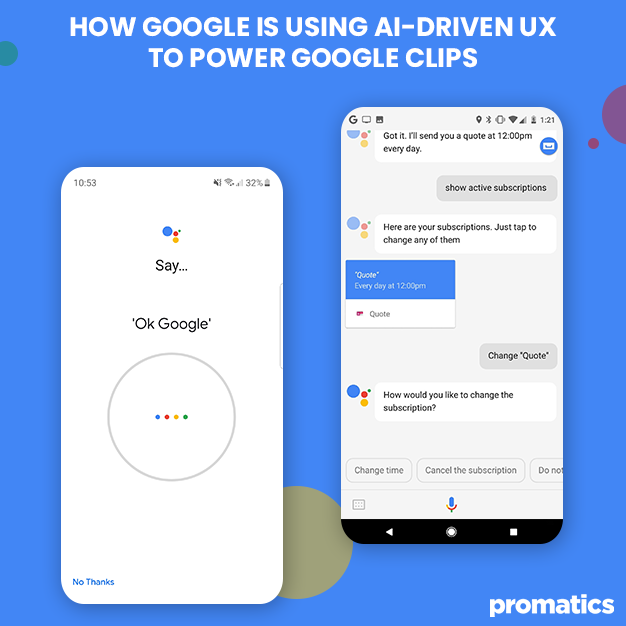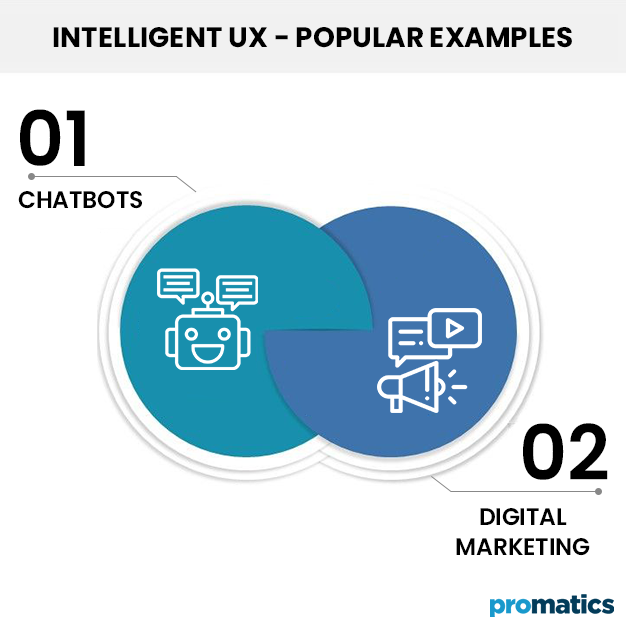Building UX for an AI application? You need to read this
We start with two buzzwords of today; Artificial intelligence AI and user experience UX.
a.) Artificial intelligence is the ability of a machine to operate intelligently, similar to how a human brain works.
b.) User experience ultimately translates into how a particular person responds to and feels about a certain interface, service, or facility.
While the two may seem at times at two opposite ends of a pole, they actually go hand in hand with each other.
The primary purpose or the answer to why AI exists is because it would be able to mimic human behavior and resultantly perform tasks that require human intellect and decision-making power. User experience serves as the perfect place of application of this modern technology where artificially intelligent systems can perform tasks and work to ultimately improve the end users’ interaction with a certain app, website, or chatbot.
What is an AI-driven user experience?
An AI-driven user experience means the engineering and step-by-step construction of a user experience that is based on data about the potential/existing users and is thoroughly analyzed using artificially intelligent systems to produce results. These results effectively end up providing greater value to the user in a more time-efficient and cost-effective manner.
How is AI-driven UX time-efficient?
Consider that AI software is used to monitor the activities of individual users on your app. A specific user opens your weather app to see tomorrow’s forecast before going to sleep at around 11 pm every day and the entire week’s forecast every Sunday night at around 12pm. Now an AI-based user experience can trigger the layout in the app to directly show the weekly forecast every Sunday and an hourly forecast every other night.
Consequently, now the user does not have to change his view settings daily to see what he desires. Thus, saving his time and energy.
How is AI-driven UX cost-effective?
For instance, you have an online store that has a daily traffic of 500,000 visitors. Out of these 500,000 visitors, 70,000 visitors ask questions about the delivery or the quality of a certain product. You have employed 1000 customer support workers to answer these queries. Each one of these has their own systems and occupy an area of 90 square meters in your office. You are bearing the labor costs of your workers, service costs of their equipment, and rent expenses of the office space that they use.
Instead, you implement an AI-driven chatbot that answers a customer’s query intelligently within 3 seconds of their question and when things are beyond their limits, the customer is redirected to a human customer support worker. Now you need fewer workers, less equipment and less office space. Most of it has been substituted with a computer in an 8 square meter room. Eventually, you end up saving valuable money that you can invest in other activities of your business.
Building blocks of AI-driven UX
The term ‘Ai-driven’ means that the user experience implemented has been concocted by using artificial intelligence not just as a tool but as an ideology. This ideology puts the user and his needs at the center and revolves around it by analyzing the data generated from this pivot.
Following are the stages of development of a UX and each of them employs AI in a unique manner and helps you present the best adapted-to-the-user interface.
I.) Design and development stage
II.) Testing stage
III.) Presentation to user stage
Let’s breakdown the above three stages and see what AI has to offer as a part of each:
- I.) Design and development
Design is always an important stage of any app or website. It can make it buttery smooth for the user to navigate through the screen or it can be the deciding point of whether the user continues with his activity or leaves the platform right away.
The UI and UX both work together in coordination with each other to bring the ultimate output. Now the UX is all about the users’ feelings and needs and the design or user interface is about blocks, the content they enclose, and the colors they are shaded in.
What if the two come together by means of AI software that can work both the bits out and do the designing and development just like how it is directed by the designer? That is possible and is in fact a reality.
AutoDraw is an AI-powered software that converts your untidily scribbled images into a perfect shape that is pleasing to the eye and might as well fit into the design that you are looking for.
That’s one way of how AI can improve the design and development stage. In the above instance, we totally ignored that the design has in fact to be coded as well. This code will run behind the screen when a user uses your app.
Exactly what teleport is doing in this video. Observe how the person simply draws onto the board and it is automatically converted into lines of code that you can easily use in your app.
- II.) Testing stage
The testing stage is very important in the life cycle of any software. It allows the company to keep up-to-date with the latest trends and keep an eye on the potential problems that may arise in a specific scenario.
Now, this testing can include A/B testing as well where you are testing a specific trait and alternate two possible scenarios to get the user’s response.
This entire process can be made more efficient with AI. AI can help to shuffle design features to create new possibilities that can be of great use to the user.
There can be two aspects to it:
- The AI simply redesigns the interface and does the laborious work for you and then you can implement it to get the user’s response.
- The AI can train the user’s behavior by learning from the available data and can provide feedback on how the user may approach it.
In short, you can use AI either on the tester’s side or the tested side. While all of it may not be possible today, there are practically uncountable possibilities of implementing the concepts. This will ultimately contribute to a more improved user experience.
- III.) Presenting-to-the-user stage
Human beings have a very characteristic trait of being unique. More than 7 billion humans walk on the earth and roam space today and while they may share traits and behaviors, each one of them still remains unique in their physical and behavioral qualities.
It is unjustified to believe that you can make one set of rules in your app/website’s UX and they are going to be perfect for every user out there. In this situation, you need a dynamic UX that can adapt to the user in no time and your user gets the customized experience.
This is precisely the manner in which cookies and recent searches can be put to use. When a user visits a website, this data can be transferred to the AI engine behind the platform. The AI performs analysis on the data and returns a customized webpage especially designed for the user. While the concept is implemented in form of ads that a user sees on the internet every now and then, it can be taken to the next level by using the same data and pulling effective information about the user out of his internet presence.
Google’s ideology behind the Clips
Google created the Google Clips that takes AI to the mobile device and helps to capture the perfect shots out of your precious moments without you needing to do literally anything.
Clips have been trained to capture a video clip under certain circumstances and then extract the perfect moment from the clip.
Following are the key points of Clips:
i.) It has been designed to address the user’s needs. Photography has often been regarded as a hindrance for a person to live in the moment. If you have a special moment in front of you, you would want to save it on your phone as a remembrance. You take out your phone, open the camera and try to take the perfect shot.
What just happened is that you took the picture but you forgot to live yourself at the moment. Clips address this dilemma of whether or not to take the picture.
ii.) Clips have a very open policy regarding the privacy of the user. Everything stays on the user’s device unless he/she allows it to be transferred elsewhere. This is particularly important to bust the myths that exist around AI and has led to an entire school of thought that considers AI as a menace and is not ready to accept it as part of their lives.
AI is at its very early stages and your user should know both; that it cannot harm him and his privacy is not intruded, as well as the fact that AI is there to assist him.
Implementations of Intelligent UX
We have learned till now that an AI-driven user experience is one that has the ability to respond to the user in an intelligent manner and not just zeros-ones or yes-no.
- Chatbots
Many of us have at least once regarded on any random site as some mechanical crap that has preset responses and will respond correctly only if we ask the appropriate question and not what we want to know about.
The good news is that today’s chatbots have evolved to be more responsive and will offer to actually answer what you are looking for. These are strongly related to natural language recognition and learn from how humans interact with each other in their everyday life.
These are especially helpful at points where your user is confused about making a decision and the chatbot can hop in to address his confusions.
- Digital Marketing
Facebook and Google ads are perhaps some of the most enhanced forms of AI today that we experience daily in every feed we scroll, whenever we open Facebook or search on Google.
Digital marketing has been practically revolutionized by these AI engines that once again focus on the experience of every user that uses social media. While it may be the perception that these tech giants are just marketing companies and all they want to do is flush ads down your mind.
The reality is quite the opposite indeed. Facebook and Google both analyze an ad on the basis of whether it is worthy to be shown to a particular user. It includes his need for the product, social proof of the product in form of post likes and engagements, and even an average user’s viewing experience. These metrics combine together to decide on the worth of each and every ad listed on Facebook.
Ultimately, Facebook Ads is trying to strike the precise balance between the needs of the business running the ad and the Facebook user viewing the ad. The same goes for Google AdWords as well.
In the nutshell….
We see the trend of UX assisting AI to accelerate in 2021 and beyond. Artificial intelligence and user experience are deeply rooted in one common objective, to make every product of the best use to the user. As AI progresses to become a strong enough technology, the user experience will further increase because machines will learn about the man and how he works and will work to bring the best utility to him.
Still have your concerns?
Your concerns are legit, and we know how to deal with them. Hook us up for a discussion, no strings attached, and we will show how we can add value to your operations!



